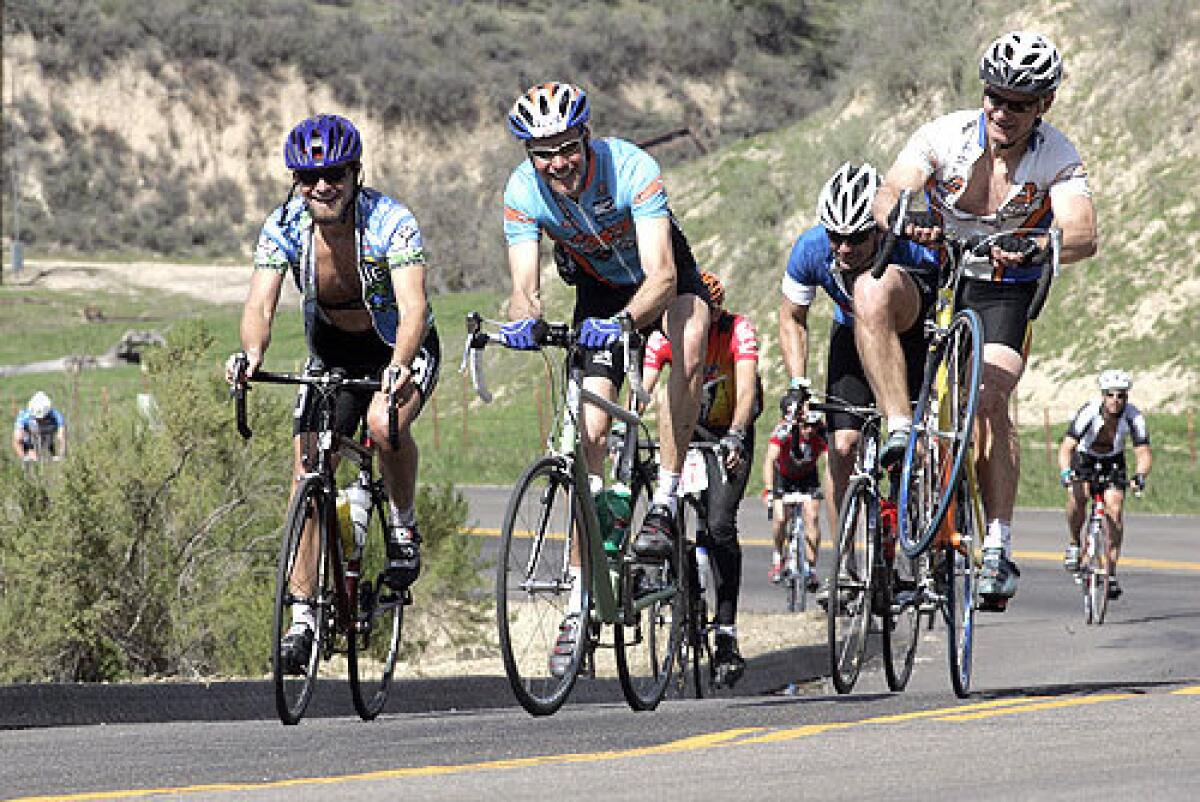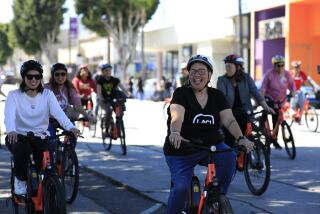The trial of the century

Pedaling a bicycle through the morning cold and fog is easy for the first mile. But there are 102 more miles to go on the Solvang Century.
Riding more than 100 miles in a day -- a century ride -- is a rite of passage and a personal goal for cyclists, like completing a first marathon is for runners. Rachelle Connell, a 43-year-old software engineer from Newbury Park, had decided this would be her first. She’d ridden centuries on the back of a tandem bike with her husband, Scott. Now, she wanted to pedal 100 miles on her own.
“I want to see if I can do it,” she said before the March ride.
The Scotts are serious about their cycling. On their wedding day, they did a 32-mile ride near Solvang on their tandem, so this was also a bit of a sentimental journey for them.
The Solvang century attracts thousands of riders each spring -- 4,850 this year. Perhaps because of the “Lance effect” (seven-time Tour de France winner Lance Armstrong raised public awareness of road cycling), participation in century rides has been on the rise. The Solvang ride is considered one of the premier centuries in Southern California because of the scenic and cyclist-friendly terrain -- and its support and organization. This year, the ride’s 25th, organizers spent more than $25,000 to hire police to control traffic at major intersections.
The ride starts and ends in the faux Danish town, looping through the rolling hills of the wine country made famous in the movie “Sideways.” Solo riders pay $60 and get a number, a route slip, a wristband, a goodie bag and all the cookies, peanut butter and jelly sandwiches, bananas and other snacks they can eat at five rest stops. There’s a 50-mile option, but the main event is the 100-mile (technically 103.5-mile) Ride, which can be an enormous physical challenge for new riders.
Rachelle hadn’t done any special training for the ride and that worried Scott. She’d been on several long rides up to 70 miles with the Conejo Valley Cyclists, a bike club in Thousand Oaks, and was counting on her fitness base from four years of cycling to get her through the 100 miles.
*
After 24 miles of pedaling in the chilly morning, the fog lifts and the Connells pass the spot where they abandoned the ride last year -- when it was raining and hailing. Rachelle Connell’s pump slips out of its holder and into the spokes in her rear wheel. She manages to stop and retrieve the pump without crashing. Later, she says that it felt good to get past this point: “It seemed to be jinxed.”
*
It’s easy to find advice on training for a century ride on the Internet. Typical 10-week training plans start the first week with a 6-mile ride on Monday, 10 miles on Tuesday and build to 30 miles on the first Saturday. Each week, mileage goes up 10% and riders get Thursdays off.
Riding six days a week for 10 weeks is fine in theory, but not very realistic for those with jobs and family obligations.
“Life intrudes,” said Marla Streb, author of the book “Bicycling Magazine’s Century Training Program.”
Streb, a former national champion mountain biker, advocates riding every other day when training for a century.
“That’s more reasonable for most of America,” she said. “And if you can’t do the day you’re supposed to ride, just try to go the next day, which was supposed to be your day off. Don’t stress about it.” Those who can’t do a longer ride should try a spinning class or do hill repeats for a more intense workout that helps climbing, she suggested. Increasing ride times about 10% a week works for beginning riders, but those with more miles in their legs might not increase ride times as much each week, said Streb. Longer rides build cardiovascular strength and get your butt accustomed to hours in the saddle.
“But if you can ride 50 miles, you can ride 100,” said Streb. She says runners who can complete a half-marathon distance in training can usually push their bodies to do the full distance during the event -- and that also applies to cycling, which has less impact on the body than running.
*
At 41 miles into the Solvang ride, Connell says she’s doing well, although the wind is a factor. “I’ve got a good wheel to stay on.” She’s been drafting behind another rider from her club while the two chase her husband. Allowing another rider to cut the wind takes about 30% less effort than riding alone. “And it’s a lot more fun,” says Streb, because of the social aspect. “You’re suffering together.”
*
Riding closely behind (or in front of) another cyclist takes some knowledge and practice. Stopping suddenly is a no-no -- it can cause the riders behind to crash, and those in front are supposed to warn following riders about rocks and potholes and other obstructions. Streb recommends getting some instruction and practice close group riding with a bike club before trying it at a century.
Not trying anything new -- anything you haven’t done in training -- at a century is also standard advice. Fifty miles into a 100-mile ride isn’t the time to find out that your stylish new bike shorts are uncomfortable or that your new shifters don’t shift.
*
At the rest stop at mile 58, Rachelle Connell says, “I’m starting to feel my bottom a bit more, and I don’t like the wind at all.” The Connells scarf down some food and refill their hydration packs.
*
Eating and drinking regularly is essential on a century ride, on which riders can easily burn 5,000 calories in the course of the day. Glycogen, which fuels muscles, is depleted after about an hour and a half of riding and needs to be replaced by carbohydrates to avoid a sudden drop in energy -- what runners and cyclists call the bonk. And losing only a few percent of blood volume from dehydration can cut athletic performance substantially.
Randy Ice, who organizes and directs the Solvang ride, said that on ride day, participants consumed 500 loaves of bread, 350 cases of water, most of the 10,000 cookies he ordered and 150 cases of fresh fruit.
The last rest stop is on Foxen Canyon Road near the Firestone Winery. Riders skip the merlot, but take on more fuel and water in preparation for “the Wall,” where the road snakes up a long hill. Scott Connell said, “You’re looking at it and saying to yourself, ‘Oh, boy, I’ve got to climb that?’ And your legs feel like rubber.”
*
At mile 97, the Connells pedal past riders who have gotten off their bikes and are pushing them up the hill. Once over the top, it’s mostly downhill to the finish and a cold beer after seven hours in the saddle.
*
This year Rachelle and her husband were among the 96% of riders who finished the 103 miles, Ice said -- a typical completion rate, except in years with bad weather. Those who decide to bail can flag down a lift from one of the five SAG vehicles that patrol the course.
And, of course, riders who finish can always sign up for a double century such as the Los Angeles Wheelmen’s ride, in June, with routes from 125 to 400 miles.
*
After passing under the finish line banner in Solvang, Rachelle Connell is ecstatic that she’s completed the ride -- and can still move.
More to Read
Start your day right
Sign up for Essential California for news, features and recommendations from the L.A. Times and beyond in your inbox six days a week.
You may occasionally receive promotional content from the Los Angeles Times.






